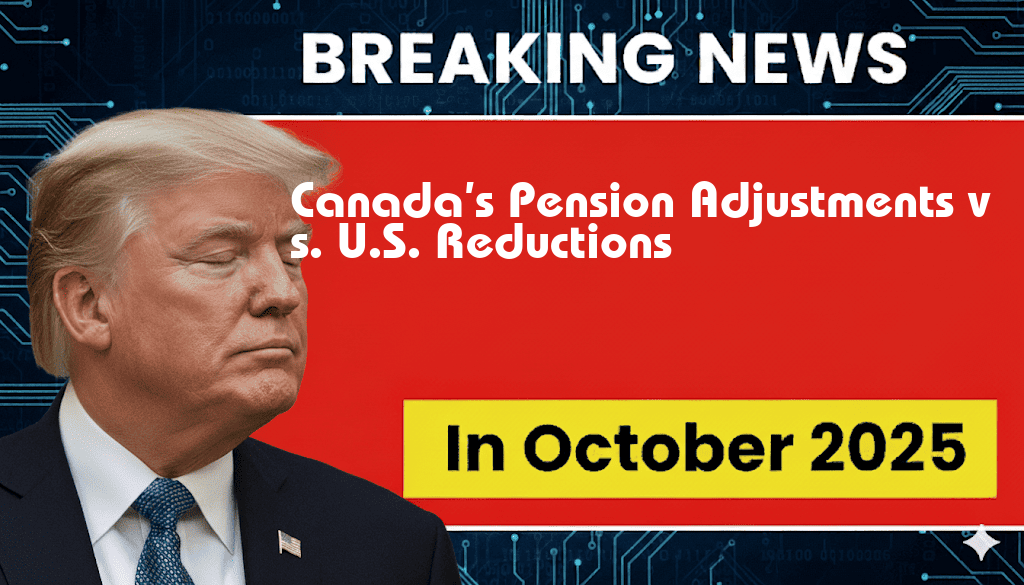Recent developments in pension adjustments have sparked discussions around the financial security of retirees in Canada versus the United States. Canada has proposed pension adjustments amounting to $825,000, which has raised eyebrows and prompted comparisons to ongoing reductions in U.S. pension plans. This article delves into the specifics of both countries’ pension strategies, examining the implications for retirees and the broader economic landscape. As financial pressures mount, understanding these differences becomes crucial for stakeholders, including policymakers, retirees, and financial planners.
The Context of Pension Adjustments
Pension systems in both Canada and the U.S. have faced significant challenges in recent years, driven by economic fluctuations, demographic shifts, and the increasing cost of living. In Canada, the recent announcement of $825,000 in pension adjustments is part of a broader strategy to enhance the financial well-being of its retirees. Conversely, the United States has seen reductions in pension benefits, particularly affecting public sector employees and private sector retirees.
Canada’s Pension Adjustments
Canada’s pension adjustment initiative aims to bolster the financial stability of its retirement income system. The proposed $825,000 adjustments will be allocated primarily to the Canada Pension Plan (CPP) and Old Age Security (OAS) programs. These adjustments are designed to address inflationary pressures and ensure that retirees can maintain their purchasing power.
Key Features of Canada’s Pension Adjustment
- Targeted Increases: The adjustments focus on low- and middle-income retirees, ensuring that those most in need receive adequate support.
- Inflation Linkage: Future adjustments are tied to inflation rates, providing a safety net against rising living costs.
- Comprehensive Review: The government has committed to regular reviews of the pension system to adapt to changing economic conditions.
U.S. Pension Reductions
In stark contrast, the U.S. has witnessed a trend toward pension benefit reductions, particularly in defined benefit plans. Many states have struggled with underfunded pension liabilities, leading to cuts in benefits for current and future retirees.
Challenges Facing U.S. Pension Plans
- Underfunding Issues: Many pension funds are significantly underfunded, prompting governments to reconsider benefits.
- Policy Changes: Legislative changes at both state and federal levels have led to reduced benefits or increased retirement ages.
- Economic Pressures: The rising costs of healthcare and living expenses have strained pension resources.
Comparative Analysis
| Feature | Canada | United States |
|---|---|---|
| Pension Adjustment Amount | $825,000 in proposed adjustments | Reductions in benefits |
| Target Demographic | Low- and middle-income retirees | Public and private sector retirees |
| Inflation Adjustment | Linked to inflation rates | No standardized inflation linkage |
Implications for Retirees
The contrasting approaches to pension management raise important questions about the future of retirement security in both countries. In Canada, the adjustments signify a proactive stance aimed at safeguarding retirees’ financial health. In contrast, the U.S. reductions may lead to increased financial insecurity among retirees, particularly those relying solely on pension income.
Looking Ahead
As Canada moves forward with its pension adjustments, the effectiveness of these measures will be closely watched. Conversely, the U.S. must grapple with its pension system’s sustainability and consider reforms that could restore confidence among retirees. Both nations face the challenge of adapting their pension frameworks to meet the demands of an aging population and a fluctuating economy.
For more information on pension systems in Canada, visit Canada Pension Plan. To understand the pension landscape in the U.S., check out Forbes on Retirement Plans.
Frequently Asked Questions
What are the key differences between Canada’s $825,000 pension adjustments and U.S. reductions?
The main differences lie in the calculation methods and regulatory frameworks governing pensions in both countries. Canada’s approach involves specific adjustments based on income thresholds, whereas U.S. reductions may vary based on federal guidelines and individual plan provisions.
How do pension adjustments in Canada impact retirees?
Pension adjustments in Canada can significantly affect retiree income, as the $825,000 figure represents a threshold that may lead to reduced benefits for those exceeding certain limits. This can influence financial planning for retirement.
What factors contribute to the differences in pension policies between Canada and the U.S.?
Factors include economic conditions, government policies, and demographic trends. Canada’s pension system is often viewed as more socially oriented, whereas the U.S. system is largely based on individual contributions and employer plans.
Are the pension adjustments and reductions subject to change?
Yes, both Canada’s pension adjustments and U.S. reductions can change due to legislative updates or economic shifts. It’s important for individuals to stay informed about policy changes that might affect their retirement benefits.
How can individuals prepare for potential pension adjustments?
Individuals can prepare by regularly reviewing their pension plans, consulting with financial advisors, and considering diversified investments to mitigate risks associated with potential reductions or adjustments in their retirement income.

Leave a Reply